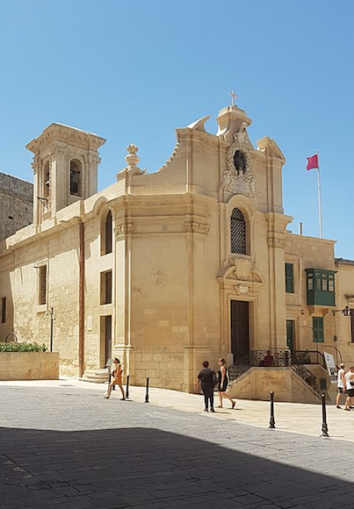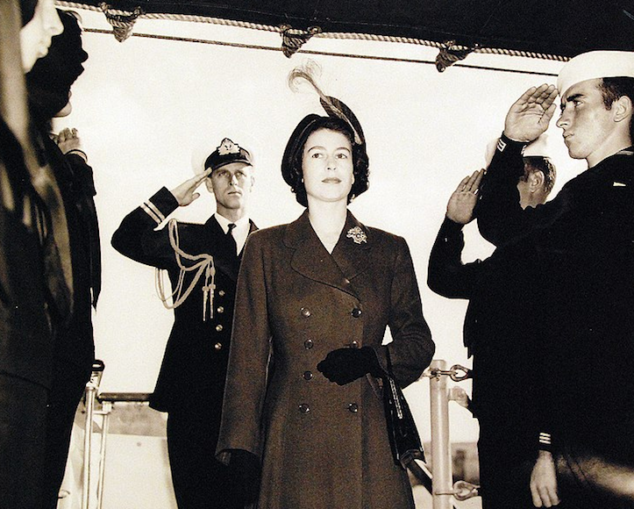
© Always Worth Saying 2022, Going Postal
At the end of the Second World War, on my father’s side of the family, the generations had passed with both grandparents dying in their sleep at ripe old ages. By VJ Day the cast of characters amongst their grandchildren was complete, although depleted as my father’s younger brother, Peter, had died as an infant, in 1936, and his oldest cousin, John, had been killed in the war.
Of the three left standing, Anne allows us relief from war-weary Britain. In 1946 her seven-year-old self and her mother Lil travelled to the exotic island of Malta to be with her father Rob who was a Royal Navy foreman in the Senior Service’s Grand Harbour dockyards. However, as we shall see, all was not well in paradise.

© Always Worth Saying 2022, Going Postal

© Always Worth Saying 2022, Going Postal

© Always Worth Saying 2022, Going Postal
The two photographs immediately above are marked on the back as ‘Carnival 1947’. On the front of the top one, the street name ‘Victory Square’ can be seen. This locates the image to the government district of Valletta, about halfway between the dockyards and navy families’ accommodations in Sliema. In picture 3, the landmark to the right is recognisable and appears on the map as ‘Kinsja Tal Votorja’.
This humble reviewer of photographs’ Maltese is a bit rusty but better than Google Translate’s which decides the fine building is a ballot box. Long-suffering readers may suspect this struggling author, while breaking bread with a moustachioed Maghrebi-Berber servant girl in Tangiers (a tall tale told previously), might have picked up enough Latinised Siculo-Arabic to know that ballot box in the Maltese dialect of such things is ‘kaxxa tal-vot’.
Although not the easiest of tongues, every Puffin will have guessed by now a better translation of ‘Kinsja Tal Votorja’ would be Church of Victory or to give the full name, the Church of Our Lady of Victory. Not a reference to triumph in the Second World War but to an Ottoman invasion repelled by the Knights of St John in 1565, with the church’s foundation stone being laid the following year. Looking battered in the picture, the church has been restored and is magnificent in the present day.

Church of Our Lady of Victory in Valletta, Malta,
Mathew Axiak – Licence CC BY-SA 4.0

Our Lady of Victory Church,
Bellina 09 – Licence CC BY-SA 4.0
With a better effort from Google, via Street View it is possible to stand on the same spot as the photograph was taken 75 years ago.
The word ‘carnival’ comes from the Latin and means put away the meat, which in turn means a feast before fasting. In Malta’s case, one last chance of excess before the austere ecclesiastical season of Lent. In 1947, the last day of carnival was on Tuesday 18th February and troubled the front page of The Hampshire Telegraph and Post Naval Chronicle. Their regular Postcard From Malta style feature noted Valletta’s crowded streets overflowed with revellers in what was Malta’s best season in the near-decade since the outbreak of war.
Last time on Nostalgia Album, we prematurely pronounced life in late nineteen forties Malta to be idyllic. Compared to post-war austerity Britain, with its continued rationing and exceptionally harsh winters, it probably was but all was not well in paradise.
Towards the end of carnival ‘rough elements’, politically motivated, were involved in a series of incidents of hooliganism. Several arrests followed. Stones were thrown at the fancy dress parade as were eggs, cauliflower and cabbages. Retaliation from the revellers resulted in numerous fights. In the evening, the police had to clear the main thoroughfare of Kingsway.
The Naval Chronicle goes on to mention coal shortages with the islanders having to hunker down early to bed, as soon as night fell, owing to a lack of fuel. An Italian merchantman, the Ezilda Croce, had been stuck in the harbour for several days because of a shortage of bunker coal. Nearby, the 2nd Battalion of the Royal Sussex regiment were replacing the 2nd Battalion, South Lancs Regiment on garrison duty. Under the alarming headline “We’ll Stop The Jews” (in those different times not prefixed by ‘careful now’) readers were informed,
“Malta is the hub of operations against illegal Jewish immigration into Palestine and, following reports that the Zionist organisations are operating an armada of “little ships” to run the blockade into Palestine, using American crews for the vessels in the hope that this will cause the British navy to think twice, the C-in-C’s Headquarters here stated that it is “the task of the Royal Navy to intercept all ships carrying illegal immigrants whatever their nationality – and stop them we will!”
Different and more proactive times for the grey funnel line! One of the vessels tasked was C Class destroyer HMS Chequers, leader of the 1st Destroyer Squadron, more of which later. The final paragraph of Postcard From Malta, tells of the destroyer HMS Stevensone’s dash home with a case of appendicitis to be operated on at the Bighi Naval Hospital at Kalkara, south of Valetta. By coincidence, the next photograph in our Nostalgia Album is of Her Majesty’s Hospital Ship Maine. The caption on the back reads,
“This is the ship Anne went on from school for first aid treatment.”
The Maine had a varied career, starting life in 1902 as the SS Panama of the Pacific Steam Navigation Company. After working the Liverpool to Spain, Portugal and South America route she became a hospital and ambulance ship during the First War. After the war, she was re-named RFA Maine and, amongst other things, was used to evacuate Greeks from the burning of Smyrna and Spaniards from their civil war.

© Always Worth Saying 2022, Going Postal
During WWII, Maine was the base hospital ship in Alexandria, active at the evacuation of Crete, the siege of Tobruk and the Allied landings on Sicily. At the end of the war, she assisted with casualties from the Greek Civil War as well as treating little girls injured at school.
Maine was decommissioned on 21st February 1947, the time of the carnival. With the miracle of Street View, I was able to find the exact place from where the photograph was taken. This is Lazzaretto Creek, off Marsamxett Harbour on the north coast of Valletta. To the right, a rising abutment with an accompanying two-bar fence is a giveaway as are the battlements in the distance which don’t belong to any of Malta’s impressive forts but to the city walls of Valletta. As further proof that Maltese isn’t the easiest of tongues, the street is called xi-xatt ta’Xbie. In the modern-day, to the left sits the Manoel Island Yacht Club which spoils the view of Manoel Island opposite.
In 1947, more warships were visible. The vessel pictured beside HMHS Maine has an outsized ‘5’ on its funnel which denotes the 5th Destroyer Flotilla. The black band above denotes it as the flotilla leader. The narrow band on the next vessel shows it to be the flotilla’s half leader. Wiki suggests the flotilla leader in 1947 was HMS Solebay although it doesn’t look like Solebay in the photo.
1947 was a significant year for Malta. In October, elections were held, the first under universal suffrage. The Labour Party won a majority of 8 in an assembly of 40, with the Maltese nationalists gaining a disappointing 7. Although at the time the Labour Party weren’t overtly in favour of Maltese independence, an ambitious troublemaker called Dom Mintoff was appointed Deputy Prime Minister and Minister of Public Works. Within 17 years, after a controversial attempt to integrate into the UK and an inconclusive referendum, the Maltese had self-rule hoisted upon them with Mintoff by then head of the Labour Party.
On 20th November 1947, Lieutenant Philip Mountbatten married Princess Elizabeth. During the week of the Duke’s memorial service, we are reminded that during the war he served in the Eastern Meditteranean and was mentioned in despatches at the battle of Cape Mattapan in 1941. By 1943 he was serving closer to Malta, as second in command of HMS Wallace, providing cover for the Allied landings in nearby Sicily,

The British Royal Highness, Princess Elizabeth and the Duke of Edinburgh,
U.S. Navy – Public domain
His uncle, Lord Mountbatten of Burma, was also in the Eastern Med as part of the 5th Destroyer Flotilla, in command of HMS Kelly which was lost at the Battle of Crete. Within two years of his marriage, Philip was posted to Malta as First Lieutenant and second in command on the leader of the 1st Destroyer Flotilla, the aforementioned HMS Chequers. Princess Elizabeth joined him.
As such, were their Royal Highnesses present at the same time as Rob, Lil and Anne? And if so, did they meet? Find out next time on Nostalgia Album.
© Always Worth Saying 2022

